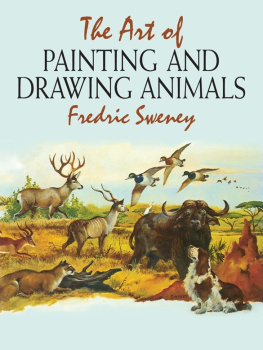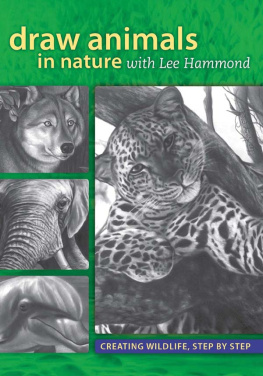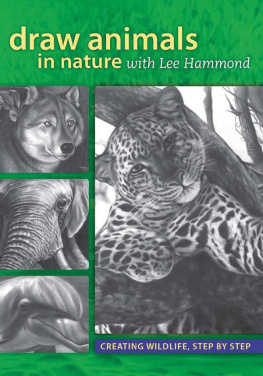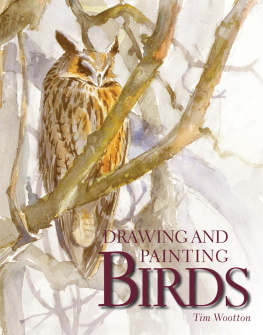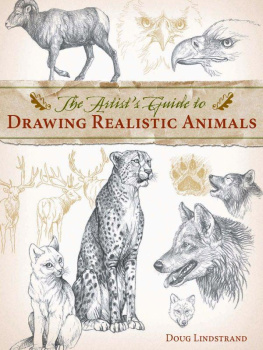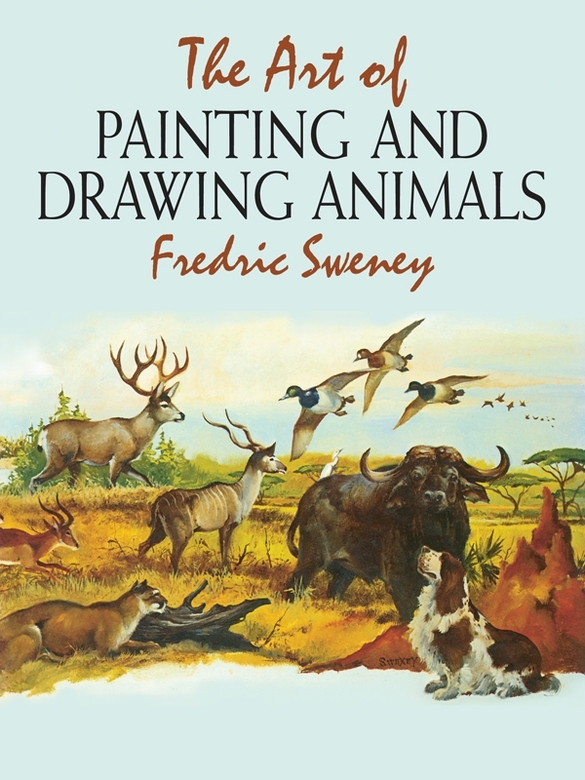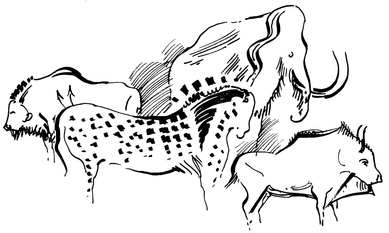I would like to give special thanks to Mary E. Kennan for her editorial knowledge and guidance, and to her staff, who helped me throughout the three years it required to write the book and make the paintings and numerous illustrations necessary to complete it.
I also want to thank Eric Newman, whose competent attention to detail and to production matters guided this book to its completion.
My sincere appreciation goes to all museums and other artists for the use of their paintings and art, and also to Viktor Schreckengost and Bill Webster for their help.
Finally, a big thank you goes to my wife and my friends for their interest and understanding.
Bibliography
ADAMS, NORMAN, and JOE SINGER. Drawing Animals. New York: Watson-Guptill Publications, 1979.
Africa, From the Sahara to the Zambesi. Peoples of the Earth Series, vol. II. Suffern, N.Y.: The Danbury Press, 1973.
AlaskaHigh Road to Adventure. Washington: National Geographic Society, 1976.
AUDUBON, JOHN JAMES. The Birds of America. New York: Macmillan, 1941.
AYMAR, GORDON C. Bird Flight. New York: Dodd, Mead, 1936.
BATES, MARSTON, and the EDITORS OF LIFE. The Land and Wildlife of South America. Alexandria, Va.: Time-Life Books, 1964.
Birds of America. Garden City, N.Y.: Garden City Publishing, 1936.
BRIDGES, WILLIAM. Wild Animals of the World. Garden City, N.Y.: Garden City Publishing, 1948.
BRIDGMAN, GEORGE E. Bridgmans Complete Guide to Drawing from Life. New York: Sterling Publishing, 1952.
CALDERON, FRANK. Animal Painting and Anatomy. New York: Dover Publications, 1975.
CARRINGTON, RICHARD. The Mammals. Alexandria, Va.: Time-Life Books, 1963.
CONRAD BARNABY. La Fiesta Brava. Boston: Houghton Mifflin, 1950.
CUTLER, MERRITT. How to Cut Drawings on Scratchboard. New York: Watson-Guptill Publications, 1949.
Domestic Descendants. Alexandria, Va.: Time-Life Films, 1979.
DUPLAIX, NICOLE, and NOEL SIMON. World Guide to Mammals. New York: Crown, 1976.
DUPONT, JACQUES, and FRANCOIS MATHEY. The Seventeenth Century: The New Development in Art from Caravaggio to Vermeer. The Great Centuries of Painting Series. Skira, 1951.
EAST, BEN. Bears. New York: Outdoor Life Crown Publishers, 1977.
ELLENBERGER, W., H. BAUM, and H. DITTRICH. An Atlas of Animal Anatomy for Artists. New York: Dover Publications, 1949.
FARB, PETER, and the EDITORS OF LIFE. Ecology. Alexandria, Va.: Time-Life Books, 1963.
FORBIS, WILLIAM H. The Cowboys. Alexandria, Va.: Time-Life Books, 1973.
FOSCA, FRANCOIS. The Eighteenth Century: Watteau to Tiepolo. The Great Centuries of Painting Series. Skira, 1952.
HIRSH, DIANA. The World of Turner: 1775-1851. Alexandria, Va.: Time-Life Books, 1969.
HULTGREN, KEN. The Art of Animal Drawing. New York: McGraw-Hill, 1950.
KEATING, BERN. Alaska. Washington: National Geographic Society, 1969.
KELLER, DR. HILTGART, and DR. BODO CICHY. 20 Centuries of Great European Painting. New York: Sterling Publishing, 1957.
KNIGHT, CHARLES R. Animal Drawing. New York: Dover Publications, 1947.
Know the American Quarter Horse. Farnum Horse Library, 1972.
KOLLER, LARRY. The Treasury of Hunting. Indianapolis, Ind.: Odyssey Press, 1965.
KUHN, BOB. The Animal Art of Bob Kuhn. North Light Publishers, 1973.
LAYCOCK, GEORGE. The Deer Hunters Bible. New York: Doubleday, 1963.
LESLIE, CLARE WALKER. Nature Drawing-A Tool for Learning. Englewood Cliffs, N.J.: Prentice-Hall, 1980.
LORGUES-LAPOUGE, C. The Old Masters: ByzantineGothic RenaissanceBaroque. New York: Crown Publishers, n.d.
LUDWIG, COY. Maxfield Parrish. New York: Watson-Guptill Publications, 1973.
Marvels and Mysteries of Our Animal World. White Plains, N.Y.: Readers Digest Association, 1964.
MILLER, MIKE. Alaska-The Great Land. New York: Sierra Club/Charles Scribners Sons, 1975.
MITCHELL, JOHN, and the MASSACHUSETTS AUDUBON SOCIETY. The Curious Naturalist. Englewood Cliffs, N.J.: Prentice-Hall, 1977.
MOORE, RUTH, and the EDITORS OF LIFE. Evolution. Alexandria, Va.: Time-Life Books, 1962.
MORGAN, NEIL, and the EDITORS OF TIME-LIFE BOOKS. The Pacific States-California, Oregon, Washington. Alexandria, Va.: Time-Life Books, 1967.
MUYBRIDGE, EADWEARD. Animals in Motion. New York: Dover Publications, 1957.
PECK, STEPHEN ROGERS. Atlas of Human Anatomy for the Artist. New York: Oxford University Press, 1951.
PERARD, VICTOR. Anatomy and Drawing. New York: Victor Perard, 1928.
PRIDEAUX, TOM, and the EDITORS OF TIME-LIFE BOOKS. The World of Delacroix: 1798-1863. Alexandria, Va.: Time-Life Books, 1966.
QUEENY, EDGAR M. Prairie Wings. Philadelphia: J. B. Lippincott, 1947.
RUE, LEONARD LEE III. The Deer of North America. New York: Outdoor Life Crown Publishers, 1978.
RUE, LEONARD LEE III. The World of the White-Tailed Deer. Philadelphia: J. B. Lippincott, 1962.
SANDERSON, IVAN T. Living Mammals of the World. New York: Doubleday, 1955.
Seven Centuries of Art-Survey and Index. Editors of Time-Life Books. Alexandria, Va.: Time-Life Books, 1970.
SIMMONS, SEYMOUR III, and MARC S.A. WINER. Drawing: The Creative Process. Englewood Cliffs, N.J.: Prentice-Hall, 1977.
SIMON, HOWARD. 500 Years of Art in Illustration from Albrecht Durer to Rockwell Kent. New York: World Publishing, 1942.
STONEHOUSE, BERNARD. Animals of the Arctic-The Ecology of the Far North. New York: Holt, Rinehart and Winston, 1971.
TANNER, OGDEN. Bears and Other Carnivores. Alexandria, Va.: Time-Life Films, 1976.
TYLER, RON. The Cowboy. New York: William Morrow, 1975.
TYNAN, KENNETH. Bull Fever. New York: Harper Brothers, 1955.
Wild Animals of North America. Washington: National Geographic Society, 1979.
Wild Herds. Alexandria, Va.: Time-Life Films, 1977.
WILWERDING, WALTER J. Animal Drawing and Painting. New York: Watson-Guptill Publications, 1946.
CHAPTER ONE
The first artist
FROM THE SLIMY, FOUL-SMELLING SWAMP of 250 million years ago, the amphibians, those sluggish creatures of the reptilian world, took their first tentative footsteps into the Paleozoic period. From this ancestral beginning the reptiles, birds, and animals had their birth. Humans did not appear until many millions of years later. The golden age of the dinosaurs lay ahead, but the first bird, Archaeopteryx, a magnificent, crow-sized, reptile-like creature with the beautiful feathers, already was here. (See .)
During this era, when gigantic, cold-blooded, egg-laying vertebrates roamed the world, many warm-blooded creatures who bore their young alive and nursed them through infancy also inhabited this planet. The mammoth and the woolly rhinoceros searched for food, and they in turn were being hunted by the Neanderthal.
The sabre-toothed tiger () still prowled the land but, inexplicably, these giantsthe mammoths, mastodons, and sabre-toothsdied quickly as the ice retreated toward the north, leaving the smaller animals, such as the rabbits, reindeer, and bison, to replenish and inhabit the earth.
The Cro-Magnon, who replaced the Neanderthal of the Stone Age 35,000 years ago, were successful in recording their impressions of the animals and birds of their time. Some of these illustrations are found on the walls and ceilings of the caves at Lascaux, Niaux, and Rouffignac in France, and at Spains Altimira Cave.

